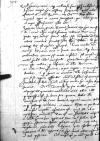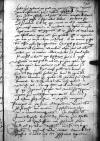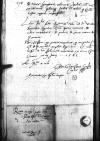Non necesse fuit Reverendissimae Dominationi Vestrae aliquam excusationem afferre, quod Reverendissima Dominatio Vestra nihil litterarum ad me per priorem nuntium dederit. Tantus ego non sum, ut id ab illa requiram, et ipse officium meum non feci, qui nuntium Reverendissimae Dominationis Vestrae abire ⌊hinc⌋ sine litteris praetermiserim, sed et occupatior tum fui, et nihil eiusmodi erat, quod scribi ad illam digne potuisset.
Sed et nunc, quid scribam, aliud non habeo praeter id, quod serenissimus ⌊rex iuvenis⌋ ⌊Cracoviam⌋ venit 1545-06-03⌊in vigilia Sacratissimi Corporis Christi1545-06-03⌋ bene valens ac incolumis. ⌊Rex pater⌋ et ⌊regina⌋ cum ⌊filiabus⌋ in templo maiore in arce ⌊illum⌋ exceperunt et amplexati sunt. Nos itidem canonici oratione non inculta, non longa ⌊illius maiestati⌋ felicem adventum gratulati sumus idque sine ⌊antistite⌋ nostro. ⌊Is⌋ tunc domo written over i⌈ioo written over i⌉ non prodierat nec in templum, nec obviam ⌊regi⌋. Ficticiam habebat aegritudinem, similiter et dominus ⌊Petrus Opaleniczki⌋. Hodie demum XII Iunii e latebris prodierunt. Varie de hoc homines loquuntur. Et serenissimus ⌊rex iuvenis⌋, et curia sua tota scivit id ita constitutum esse, dum adhuc esset in media via, ambos hos ⌊dominos⌋ ex composito aegrotatur written over t⌈trr written over t⌉os, ⌊regi⌋ obviam non progressuros, nisi nona demum die post adventum suae maiestatis. Aiunt, quod teste conscientia et metu operum, quae adversum hunc ⌊dominum⌋ suum fecerunt, timent sibi non mediocriter. Nullus aulicorum ⌊regis iunioris⌋ ivit ad domum ⌊archiepiscopi⌋ salutatum illum. In convivi<i>s, ad on the margin⌈adad on the margin⌉ quae written over o⌈oaeae written over o⌉ vocatur frequenter, cum provocantur poculis, ut in salutem ⌊archiepiscopi⌋ bibant, non assurgunt, non honorem faciunt, pocula non accipiunt, bibere dedignantur aulici ⌊regis iunioris⌋.  BCz, 247, p. 394 Quod ⌊homini⌋ vano atque ambitioso sane perquam molestum est. Sperni incipit hoc ⌊monstrum⌋ sacrorum. Quid credit futurum Dominatio Vestra Reverendissima, cum serenissimus ⌊rex filius⌋ imperium ⌊Regni⌋ in manus sumpserit, qui
cf. Adagia 1863 cane peius et angue odit ⌊cane peius et angue frascarios istos oditcf. Adagia 1863 cane peius et angue odit ⌋
?
BCz, 247, p. 394 Quod ⌊homini⌋ vano atque ambitioso sane perquam molestum est. Sperni incipit hoc ⌊monstrum⌋ sacrorum. Quid credit futurum Dominatio Vestra Reverendissima, cum serenissimus ⌊rex filius⌋ imperium ⌊Regni⌋ in manus sumpserit, qui
cf. Adagia 1863 cane peius et angue odit ⌊cane peius et angue frascarios istos oditcf. Adagia 1863 cane peius et angue odit ⌋
?
Quarum rerum gratia serenissimus ⌊iuvenis rex⌋ ⌊huc⌋ venisse dicitur, earum adhuc nihil factum videmus. Nam cum ⌊patre rege⌋ non nisi semel adhuc sese cum patre concluserant hidden by binding⌈[ant hidden by binding, possibly at⌈antant hidden by binding, possibly at⌉]ant hidden by binding⌉ ceteris omnibus semotis praeter ⌊episcopum Plocensem⌋, de quo ⌊uterque rex⌋ est optime persuasus. Cum ⌊matre⌋ etiam non <n>isi bis una erat in secreto conclavi idque breviter admodum. Armat sese ⌊mater⌋ in ⌊filium⌋, sed causam iustam hidden by binding⌈[am]am hidden by binding⌉ nullam habet illum incusandi. Quarum tamen haec maxima una esse creditur, quod ⌊Lithuania⌋ ⌊eo⌋ illic dominante ac recta iudicia faciente caput erigere et reviviscere dicitur et quod honor ac reverentia illa Lithuanica, qua sese ⌊regina⌋ efferebat, omnis ad filium est conversa. Incredibile est dictu, quam ab omnibus ametur ⌊hic⌋ iustus ⌊rex iuvenis⌋. Dominus ⌊Tarnowski⌋ ex suo in ⌊illum⌋ amore cum quingentis primariae nobilitatis viris obviam illi progressus est. In bonis suis quattuor diebus ⌊illum⌋ lautissime cum tota curia tractavit, ingentia munera dedit eaque pleraque militaria et oratione diserta ac prudenti ad iustum imperium cohortatus est. Quod ⌊ille⌋ ab ⌊eo⌋ cupidissime audivit. Non est meae facultatis aliquid in laudem huius boni ⌊regis⌋ vel dicere, vel scribere, sed egregia specimina virtutum, probitatis, iustitiae, recti iudicii, vigilantiae, sobrietatis, religionis, pulchre ostendere coepit. Speramus et Deum rogamus, ut his initiis cetera responondeant hidden by binding⌈[t]t hidden by binding⌉ in aetate posteriore.
cf. Hor. Carm. 2.16.27-28 nihil est ab omni parte beatum ⌊Sed nihil est ex omni parte beatum hidden by binding⌈[tum]tum hidden by binding⌉cf. Hor. Carm. 2.16.27-28 nihil est ab omni parte beatum ⌋.  BCz, 247, p. 395 Habet hic optimus ⌊rex⌋, quod eum excruciet, nempe ⌊uxoris⌋ gravis infirmitas, quae a caduco infestatur [...] stain⌈[...][...] stain⌉. 1545-03-22⌊Dominica enim Iudica praeterita1545-03-22⌋ ad horam decimam correpta conciderat, hoc ipsum passa et sequentibus diebus. Occultatur hoc ab hominibus, sed ⌊rex⌋ ipse vocato me ad se mandav haec mihi narravit ac mandavit, ut magistros ac astrologos convenirem, u written over ...⌈... illegible⌈...... illegible⌉uu written over ...⌉t perquirerent illi ex fatis et nativitate ac constellatione ⌊reginae⌋, an haec aegritudo esset ei ingenita, an vero ex causa aliqua accidentali, et an curari posset. Nihil adhuc astrologi responderunt. Scripsitque serenissimus ⌊rex iuvenis⌋ ad ⌊socerum⌋, ut medicum aliquem suum ad ⌊illam⌋ mittat, qui et curationi illius intendat, et simul testis sit nihil in serenissimo rege desiderare hac in re posse. Vehementer ea res aegritudo nos omnes, qui huic optimo ⌊regi⌋, optimae ⌊reginae⌋ bene volumus, sed Dei voluntas sit, necesse est.
BCz, 247, p. 395 Habet hic optimus ⌊rex⌋, quod eum excruciet, nempe ⌊uxoris⌋ gravis infirmitas, quae a caduco infestatur [...] stain⌈[...][...] stain⌉. 1545-03-22⌊Dominica enim Iudica praeterita1545-03-22⌋ ad horam decimam correpta conciderat, hoc ipsum passa et sequentibus diebus. Occultatur hoc ab hominibus, sed ⌊rex⌋ ipse vocato me ad se mandav haec mihi narravit ac mandavit, ut magistros ac astrologos convenirem, u written over ...⌈... illegible⌈...... illegible⌉uu written over ...⌉t perquirerent illi ex fatis et nativitate ac constellatione ⌊reginae⌋, an haec aegritudo esset ei ingenita, an vero ex causa aliqua accidentali, et an curari posset. Nihil adhuc astrologi responderunt. Scripsitque serenissimus ⌊rex iuvenis⌋ ad ⌊socerum⌋, ut medicum aliquem suum ad ⌊illam⌋ mittat, qui et curationi illius intendat, et simul testis sit nihil in serenissimo rege desiderare hac in re posse. Vehementer ea res aegritudo nos omnes, qui huic optimo ⌊regi⌋, optimae ⌊reginae⌋ bene volumus, sed Dei voluntas sit, necesse est.
Dixit mihi quidam vir bonus, quod serenissimus ⌊rex Angliae⌋ habeat hoc donum Dei, quod a tali passione liberantur hi, quibus ille anulum suum consecratum donaverit. Si id Reverendissima Dominatio Vestra umquam audivit et verum esse scit, oro atque obsecro, ut id vel mihi, vel ipsi ⌊regi⌋ quamprimum significet, vel anulum hunc quamprimum impetret huic nobilissimae ⌊reginae⌋ m written over a⌈amm written over a⌉itti. Scio enim, quod ex ⌊Gdano⌋ frequentissimi in ⌊Angliam⌋ navigant.
⌊Principes⌋ nostri XV Iunii ad ⌊Niepolomice⌋ venatum ibunt. Ibi fortasse loco venationum expostulationes aliquae, irae et reconciliationes erunt. 1545-06-25⌊In crastino sancti Ioannis Baptistae1545-06-25⌋ serenissimus ⌊rex iunior⌋ hinc discedit, primum ad ⌊Cząstochowa⌋ voti persolvendi gratia, inde ad ⌊Pyotrkow⌋, ⌊Varssoviam⌋, ⌊Lomsam⌋, ⌊Tykocyn⌋, ⌊Grodnam⌋ ac postmodum ⌊Vilnam⌋ iturus. Dominus Deus gressus et actus ⌊eius⌋ omnes prosperare dignetur.
 BCz, 247, p. 396
BCz, 247, p. 396
De ⌊Turcis⌋, ⌊Hungaris⌋, ⌊Almanis⌋, ⌊Italis⌋ nihil nunc audimus. Plerique scribunt et credunt, quod ⌊concilium⌋ ⌊caesare⌋ cogente congregabitur.
Litteras ⌊reginalis maiestatis⌋ Reverendissima Dominatio Vestra ad dominum ⌊Werden hidden by binding⌈[n]n hidden by binding⌉⌋ transmittere dignetur. Sunt parvi momenti de rebus mercatoriis, de pannis, de auro coemendo pro moneta.
Dominationi Vestrae Reverendissimae ago gratias maximas, quod me gratia sua nihil de se meritum complecti dignatur. Cui vitam longam et omnis felicitatis incrementa ex animo precor.
 BCz, 247, p. 394 Quod
BCz, 247, p. 394 Quod  BCz, 247, p. 395 Habet hic optimus
BCz, 247, p. 395 Habet hic optimus 


